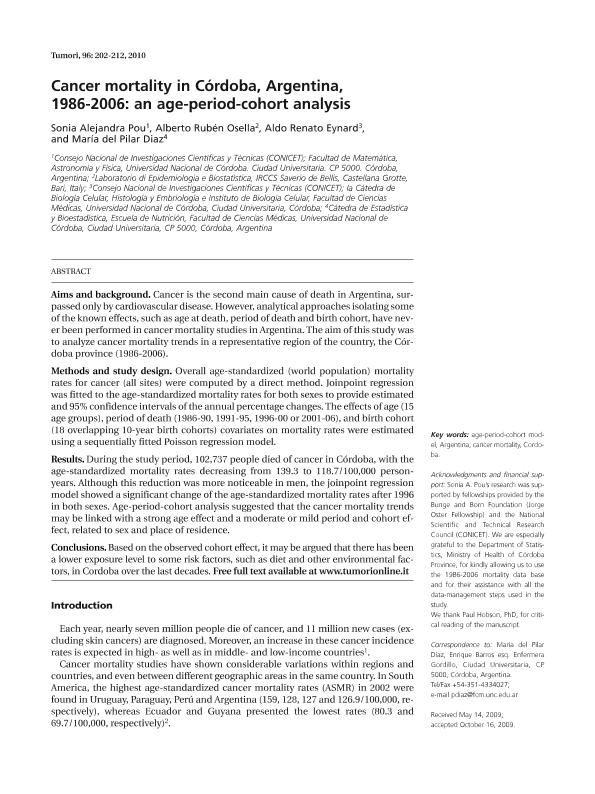Mostrar el registro sencillo del ítem
dc.contributor.author
Pou, Sonia Alejandra

dc.contributor.author
Osella, Alberto Rubén

dc.contributor.author
Eynard, Aldo Renato

dc.contributor.author
Diaz, Maria del Pilar

dc.date.available
2021-04-20T16:08:57Z
dc.date.issued
2018-01
dc.identifier.citation
Pou, Sonia Alejandra; Osella, Alberto Rubén; Eynard, Aldo Renato; Diaz, Maria del Pilar; Cancer Mortality in Córdoba, Argentina, 1986–2006: An Age-Period-Cohort Analysis; Pensiero Scientifico Editor; Tumori; 96; 2; 1-2018; 202-212
dc.identifier.issn
0300-8916
dc.identifier.uri
http://hdl.handle.net/11336/130487
dc.description.abstract
Aims and background. Cancer is the second main cause of death in Argentina, surpassed only by cardiovascular disease. However, analytical approaches isolating some of the known effects, such as age at death, period of death and birth cohort, have never been performed in cancer mortality studies in Argentina. The aim of this study was to analyze cancer mortality trends in a representative region of the country, the Córdoba province (1986-2006). Methods and study design. Overall age-standardized (world population) mortality rates for cancer (all sites) were computed by a direct method. Joinpoint regression was fitted to the age-standardized mortality rates for both sexes to provide estimated and 95% confidence intervals of the annual percentage changes. The effects of age (15 age groups), period of death (1986-90, 1991-95, 1996-00 or 2001-06), and birth cohort (18 overlapping 10-year birth cohorts) covariates on mortality rates were estimated using a sequentially fitted Poisson regression model. Results. During the study period, 102,737 people died of cancer in Córdoba, with the age-standardized mortality rates decreasing from 139.3 to 118.7/100,000 personyears. Although this reduction was more noticeable in men, the joinpoint regression model showed a significant change of the age-standardized mortality rates after 1996 in both sexes. Age-period-cohort analysis suggested that the cancer mortality trends may be linked with a strong age effect and a moderate or mild period and cohort effect, related to sex and place of residence. Conclusions.Based on the observed cohort effect, it may be argued that there has been a lower exposure level to some risk factors, such as diet and other environmental factors, in Cordoba over the last decades. Free full text available at www.tumorionline.it
dc.format
application/pdf
dc.language.iso
eng
dc.publisher
Pensiero Scientifico Editor

dc.rights
info:eu-repo/semantics/openAccess
dc.rights.uri
https://creativecommons.org/licenses/by-nc-sa/2.5/ar/
dc.subject
AGE-PERIOD-COHORT MODEL
dc.subject
ARGENTINA
dc.subject
CANCER MORTALITY
dc.subject
CORDOBA
dc.subject.classification
Epidemiología

dc.subject.classification
Ciencias de la Salud

dc.subject.classification
CIENCIAS MÉDICAS Y DE LA SALUD

dc.title
Cancer Mortality in Córdoba, Argentina, 1986–2006: An Age-Period-Cohort Analysis
dc.type
info:eu-repo/semantics/article
dc.type
info:ar-repo/semantics/artículo
dc.type
info:eu-repo/semantics/publishedVersion
dc.date.updated
2021-04-09T16:21:54Z
dc.journal.volume
96
dc.journal.number
2
dc.journal.pagination
202-212
dc.journal.pais
Italia

dc.description.fil
Fil: Pou, Sonia Alejandra. Universidad Nacional de Córdoba. Facultad de Matemática, Astronomía y Física; Argentina. Consejo Nacional de Investigaciones Científicas y Técnicas. Centro Científico Tecnológico Conicet - Córdoba; Argentina
dc.description.fil
Fil: Osella, Alberto Rubén. Istituto Nazionale Di Ricovero E Cura A Carattere Scientifico "saverio de Bellis". Laboratorio Di Epidemiologia E Biostatistica.; Italia
dc.description.fil
Fil: Eynard, Aldo Renato. Universidad Nacional de Córdoba. Facultad de Ciencias Exactas, Físicas y Naturales. Cátedra de Biología Celular; Argentina. Universidad Nacional de Córdoba. Facultad de Medicina. Instituto de Biología Celular; Argentina. Consejo Nacional de Investigaciones Científicas y Técnicas. Centro Científico Tecnológico Conicet - Córdoba; Argentina
dc.description.fil
Fil: Diaz, Maria del Pilar. Universidad Nacional de Córdoba. Facultad de Medicina. Escuela de Nutrición. Cátedra de Estadística y Bioestadística; Argentina. Consejo Nacional de Investigaciones Científicas y Técnicas. Centro Científico Tecnológico Conicet - Córdoba; Argentina
dc.journal.title
Tumori

dc.relation.alternativeid
info:eu-repo/semantics/altIdentifier/url/https://journals.sagepub.com/doi/abs/10.1177/030089161009600204
dc.relation.alternativeid
info:eu-repo/semantics/altIdentifier/doi/https://doi.org/10.1177%2F030089161009600204
Archivos asociados
